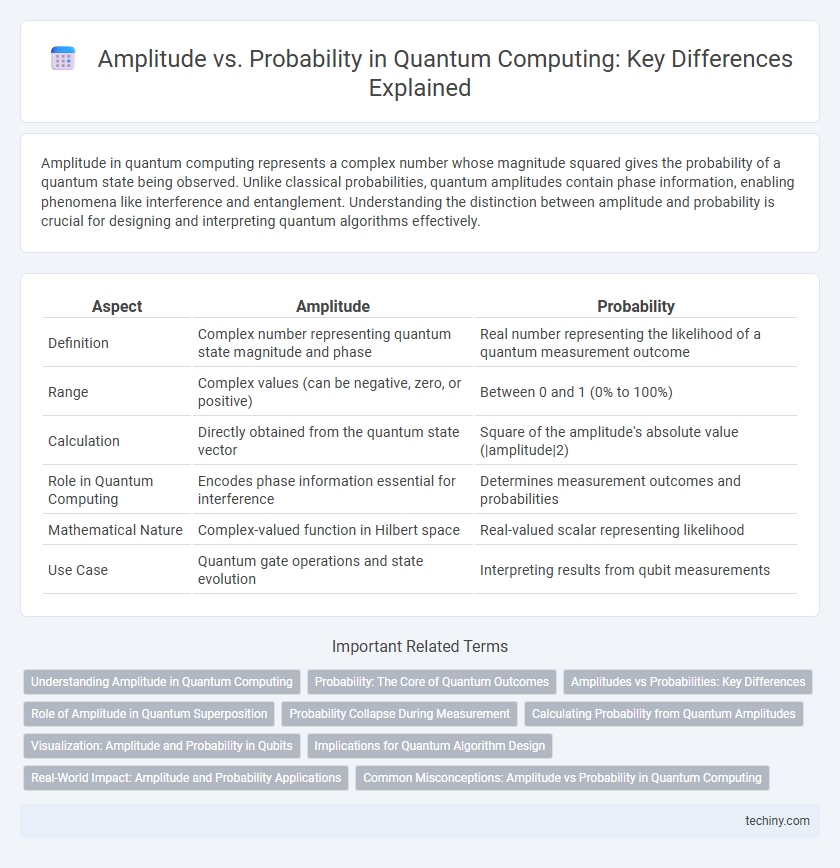Amplitude in quantum computing represents a complex number whose magnitude squared gives the probability of a quantum state being observed. Unlike classical probabilities, quantum amplitudes contain phase information, enabling phenomena like interference and entanglement. Understanding the distinction between amplitude and probability is crucial for designing and interpreting quantum algorithms effectively.
Table of Comparison
| Aspect | Amplitude | Probability |
|---|---|---|
| Definition | Complex number representing quantum state magnitude and phase | Real number representing the likelihood of a quantum measurement outcome |
| Range | Complex values (can be negative, zero, or positive) | Between 0 and 1 (0% to 100%) |
| Calculation | Directly obtained from the quantum state vector | Square of the amplitude's absolute value (|amplitude|2) |
| Role in Quantum Computing | Encodes phase information essential for interference | Determines measurement outcomes and probabilities |
| Mathematical Nature | Complex-valued function in Hilbert space | Real-valued scalar representing likelihood |
| Use Case | Quantum gate operations and state evolution | Interpreting results from qubit measurements |
Understanding Amplitude in Quantum Computing
Amplitude in quantum computing represents a complex number whose magnitude squared determines the probability of a quantum state being observed upon measurement. It encodes both the likelihood and phase information essential for quantum interference and superposition. Understanding amplitude is crucial for manipulating qubits and optimizing quantum algorithms, as it directly influences computation outcomes.
Probability: The Core of Quantum Outcomes
Probability is the fundamental measure determining the likelihood of observing specific outcomes in quantum computing, derived from the square of the amplitude's magnitude. Unlike amplitude, which can be complex and exhibit interference effects, probability represents real, non-negative values that drive the collapse of quantum states upon measurement. Understanding probability distributions is essential for interpreting quantum algorithms and predicting measurement results accurately.
Amplitudes vs Probabilities: Key Differences
Amplitude in quantum computing refers to a complex number associated with a quantum state, determining its phase and magnitude, while probability is the squared modulus of the amplitude representing the likelihood of measuring that state. Unlike classical probabilities, amplitudes can interfere constructively or destructively due to their wave-like nature, enabling quantum algorithms to exploit superposition and entanglement. Understanding the distinction between amplitudes as foundational complex coefficients and probabilities as measurable outcomes is essential for designing and analyzing quantum circuits.
Role of Amplitude in Quantum Superposition
Amplitude in quantum superposition represents the complex coefficient associated with each basis state, determining the probability and phase of the state upon measurement. The probability of observing a particular quantum state is the squared magnitude of its amplitude, linking amplitude directly to observable outcomes. Manipulating amplitudes through quantum gates enables interference patterns essential for quantum algorithms and computational advantage.
Probability Collapse During Measurement
Quantum computing relies on the principle that quantum states are represented by amplitudes, complex numbers whose squared magnitudes determine measurement probabilities. When a qubit is measured, the superposition of amplitudes collapses into a definite state, causing the probability distribution to reduce from multiple possible outcomes to a single observed value. This probability collapse is fundamental to quantum algorithms, enabling them to leverage superposition and interference before measurement yields a classical binary result.
Calculating Probability from Quantum Amplitudes
Quantum amplitudes are complex numbers that describe the state of a quantum system, and their magnitudes squared yield the probabilities of observing corresponding outcomes. Calculating probability from quantum amplitudes involves taking the modulus squared of the amplitude, which ensures values lie between 0 and 1, representing valid probability measures. This fundamental step bridges the mathematical framework of quantum mechanics with empirical measurement, enabling prediction of quantum state behavior.
Visualization: Amplitude and Probability in Qubits
Amplitude in quantum computing represents the complex coefficient associated with a qubit's state and contains both magnitude and phase information, which can be visualized using vector diagrams or Bloch spheres. Probability is derived from the amplitude's magnitude squared and corresponds to the likelihood of measuring the qubit in a particular state, typically illustrated as the length of a vector projection onto computational basis states. Visual tools like the Bloch sphere effectively demonstrate how variations in amplitude phases influence interference patterns, while probability distributions clarify measurement outcomes in algorithms such as quantum search or quantum teleportation.
Implications for Quantum Algorithm Design
Amplitude represents the complex coefficient associated with a quantum state's basis vector, while probability is the squared magnitude of this amplitude determining measurement outcomes. Designing quantum algorithms requires precise manipulation of amplitudes to maximize the probability of desired results upon measurement. Optimizing amplitude interference patterns enables algorithms like Grover's search to achieve speedups unattainable by classical counterparts.
Real-World Impact: Amplitude and Probability Applications
In quantum computing, the amplitude represents the complex probability amplitude of a qubit's state, directly influencing the likelihood of specific measurement outcomes. Real-world applications leverage amplitude manipulation in algorithms like Grover's search, enhancing search efficiency beyond classical limits by increasing the probability of finding the correct solution. The relationship between amplitude and probability enables advancements in cryptography, optimization, and drug discovery by harnessing quantum superposition and interference effects.
Common Misconceptions: Amplitude vs Probability in Quantum Computing
Amplitude in quantum computing represents a complex number encoding the likelihood and phase of a quantum state, whereas probability is the squared magnitude of this amplitude and always real-valued between 0 and 1. A common misconception is treating amplitude directly as probability, ignoring the essential step of squaring the amplitude's modulus to obtain measurable probabilities. Understanding the distinction between amplitude as a complex vector component and probability as its squared magnitude is crucial for accurately interpreting quantum measurement outcomes.
Amplitude vs Probability Infographic

 techiny.com
techiny.com